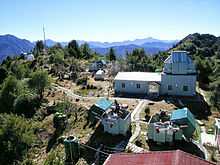Lulin Observatory
| Lulin Observatory | |||||
|---|---|---|---|---|---|
 TAOS site hualien | |||||
| Organization | National Central University | ||||
| Code | D35 | ||||
| Location | Mount Lulin, central Taiwan | ||||
| Coordinates | 23°28′07″N 120°52′25″E / 23.46861°N 120.87361°ECoordinates: 23°28′07″N 120°52′25″E / 23.46861°N 120.87361°E | ||||
| Altitude | 2,862 m (9,390 ft) | ||||
| Weather | ~200 clear nights/year | ||||
| Established | 1999 | ||||
| Website | www.lulin.ncu.edu.tw | ||||
| Telescopes | |||||
| |||||
Lulin Observatory (Chinese: 鹿林天文台; pinyin: Lùlín Tiānwéntái; literally: "Deer Forest Astronomical Observatory") is an astronomical observatory operated by the Institute of Astronomy, National Central University in Taiwan.
It is located at the summit of Mount Lulin, on the border of Chiayi County and Nantou County, near Yushan National Park. In 2007, Comet Lulin (C/2007 N3), which will come nearest the Earth on 24 February 2009, was found by this observatory.
The Lulin 1 meter had its first light in September 2002, after 10 years of development.[1]
Telescopes
- LOT Cassegrain telescope (D=1-m, f/8)
- SLT R-C telescope (D=0.40-m, f/8.8) by RC Optical Systems [2] or 76-cm Super Light Telescope (SLT)
- Four TAOS robotic telescopes (D=0.50-m, f/1.9)
Projects
- Taiwanese-American Occultation Survey (TAOS)
- Lulin Emission Line Imaging Survey (LELIS)
- LUlin Sky Survey (LUSS)
See also
- List of observatories
References
- W.S. Tsay, B. C. Chen, K.H. Chang, et al., 2001, “The NCU Lu-Lin Observatory”, in Proceedings of the IAU Colloquium 183 “Small-Telescope on Global Scales”, eds. W.P. Chen, C. Lemme, B. Paczynski, ASP.